Test Bank for Fundamentals of Management: Essential Concepts and Applications, 9/E 9th Edition Stephen P Robbins, David A. De Cenzo, Mary Coulter
$38.00
ISBN-10: 013349991X
ISBN-13: 9780133499919
For Principles of Management courses.
The practical tools of management presented through in-depth practice
Fundamentals of Management is a brief, paperback text that gives students more depth and breadth with practical tools to practice their management skills than any other textbook. The Ninth Edition introduces a new and exciting design and includes new chapter openers, case applications, and exercises.
- Description
- Reviews (0)
Description
You will receive this product immediate after placing the order
ISBN-10: 013349991X
ISBN-13: 9780133499919
For Principles of Management courses.
The practical tools of management presented through in-depth practice
Fundamentals of Management is a brief, paperback text that gives students more depth and breadth with practical tools to practice their management skills than any other textbook. The Ninth Edition introduces a new and exciting design and includes new chapter openers, case applications, and exercises.
Fundamentals of Management, 9e (Robbins)
Chapter 1 Managers and Management
1) Part of what defines an organization is its purpose.
Answer: TRUE
Explanation: The goals or purpose of an organization define the organization’s reason for existing. Without a common purpose, a group of individuals does not qualify as an organization.
Diff: 2
Objective: 1.1
Learning Outcome: Describe the roles of managers and the skills they need to succeed within an organization
2) All organizations have a structure that in some ways serves to define and limit the behavior of members of the organization.
Answer: TRUE
Explanation: The structure of an organization, whether formal or informal, defines how organization members interact. For example, a school’s informal guidelines might determine how teachers fraternize. A school’s formal guidelines might set up rules for interaction between students and teachers.
Diff: 2
Objective: 1.1
Learning Outcome: Describe the roles of managers and the skills they need to succeed within an organization
3) In order to be considered a manager, an individual must direct or oversee the work of others.
Answer: TRUE
Explanation: Directing and overseeing work distinguishes managers from nonmanagerial employees. Managers direct and oversee work of others. Nonmanagerial employees have no supervisory responsibilities.
Diff: 2
Objective: 1.1
Learning Outcome: Describe the roles of managers and the skills they need to succeed within an organization
4) A manager does not work directly on tasks for the organization.
Answer: FALSE
Explanation: Managers may work on tasks in addition to their supervisory duties. For example, a manager of a shop that designs clothing may also create designs on his or her own.
Diff: 2
Objective: 1.1
Learning Outcome: Describe the roles of managers and the skills they need to succeed within an organization
5) Supervisors and team leaders may both be considered first-line managers.
Answer: TRUE
Explanation: First-line managers are managers who oversee workers directly and are involved in day-to-day operations. For example, a team manager in an auto assembly plant might oversee and help solve everyday problems that arise on the assembly line. Higher-level managers typically would not spend time helping to solve assembly line problems directly.
Diff: 1
Objective: 1.1
Learning Outcome: Describe the roles of managers and the skills they need to succeed within an organization
6) Effectiveness refers to the relationship between inputs and outputs.
Answer: FALSE
Explanation: Efficiency is concerned with maximizing the output-to-input ratio. Effectiveness, on the other hand, refers not to how well resources are used but to which resources to use, and whether or not those resources help the organization attain its goals.
Diff: 2
Objective: 1.2
Learning Outcome: Describe the roles of managers and the skills they need to succeed within an organization
7) A goal of efficiency is to minimize output costs while maximizing input costs.
Answer: FALSE
Explanation: The goal of efficiency is the opposite—to maximize outputs while minimizing inputs. An efficient operation uses the fewest resources to generate the greatest amount of product.
Diff: 2
Objective: 1.2
Learning Outcome: Describe the roles of managers and the skills they need to succeed within an organization
8) Effectiveness refers to the attainment of the organization’s goals.
Answer: TRUE
Explanation: Effectiveness is concerned with “doing the right things”—choosing the tasks that will help the organization achieve its goals. Efficiency, on the other hand, refers to “doing things right,” that is, once tasks are chosen they are done with a minimum of waste.
Diff: 2
Objective: 1.2
Learning Outcome: Describe the roles of managers and the skills they need to succeed within an organization
9) Managers who are effective at meeting organizational goals always act efficiently.
Answer: FALSE
Explanation: A manager may be effective but not efficient. For example, a manager may excel at achieving goals but waste a lot of money, energy, and resources in achieving them.
Diff: 3
Objective: 1.2
Learning Outcome: Describe the roles of managers and the skills they need to succeed within an organization
10) The four contemporary management processes are planning, organizing, leading, and commanding.
Answer: FALSE
Explanation: Leading is a term that replaced commanding and coordinating. So commanding is considered to be part of leading and not distinct from it.
Diff: 1
Objective: 1.2
Learning Outcome: Describe the roles of managers and the skills they need to succeed within an organization
11) Determining who reports to whom is part of the controlling function of management.
Answer: FALSE
Explanation: The controlling function is largely a process of monitoring and evaluation. Subordinates are observed to see if they are working efficiently. Programs are evaluated to make sure they are progressing toward organizational goals. Deciding who reports to whom is not a part of this function.
Diff: 1
Objective: 1.3
Learning Outcome: Describe the roles of managers and the skills they need to succeed within an organization
12) Providing motivation is part of the controlling function of management.
Answer: FALSE
Explanation: Motivating employees falls under the category of leadership for a manager, not controlling.
Diff: 2
Objective: 1.3
Learning Outcome: Describe the roles of managers and the skills they need to succeed within an organization
13) Defining goals is a key part of the organizing function of management.
Answer: FALSE
Explanation: Defining goals for an organization is part of the planning, rather than the organizing, function of management. Usually only top managers participate in defining broad, strategic goals, while all managers define goals for practical levels of organization operation.
Diff: 1
Objective: 1.3
Learning Outcome: Describe the roles of managers and the skills they need to succeed within an organization
14) Deciding who will be assigned to which job is a part of the leading function of management.
Answer: FALSE
Explanation: Assigning tasks falls largely in the category of organizing. Leading is concerned with directing and motivating employees.
Diff: 1
Objective: 1.3
Learning Outcome: Describe the roles of managers and the skills they need to succeed within an organization
15) Fayol’s management processes are completely equivalent to Mintzberg’s management roles.
Answer: FALSE
Explanation: Fayol’s four functions of management are planning, leading, controlling, and organizing. Mintzberg’s categories include some of these functions, such as leading and making planning decisions, but leave out the others. Though the two systems can ultimately be reconciled with one another, it would be a stretch to say that they are equivalent. The strength of the two systems is that they represent different points of view and provide two different lenses with which to observe and analyze management.
Diff: 3
Objective: 1.3
Learning Outcome: Summarize the major historical and current approaches to management
16) In Mintzberg’s view, the roles of figurehead, leader, and liaison are all interpersonal roles.
Answer: TRUE
Explanation: Mintzberg sees the manager’s interpersonal chores as providing motivation and support (leading), representing the part of the organization you control (figurehead), and connecting with other parts of the organization and/or the outside world (liaison).
Diff: 2
Objective: 1.3
Learning Outcome: Summarize the major historical and current approaches to management
17) Disturbance handler is one of Mintzberg’s interpersonal roles.
Answer: FALSE
Explanation: Though “disturbance handler” sounds like an interpersonal role, it falls under Mintzberg’s category of decisional roles. A disturbance handler must decide how to address problems that arise in a way that will best benefit the organization.
Diff: 2
Objective: 1.3
Learning Outcome: Summarize the major historical and current approaches to management
18) A key difference between Fayol’s and Mintzberg’s view of management is that Fayol’s view was based on empirical observations of managers in action.
Answer: FALSE
Explanation: It was Mintzberg, rather than Fayol, who based his categories on what managers actually do. Fayol’s categories were based on experience, but his data was not collected in a systematic manner.
Diff: 2
Objective: 1.3
Learning Outcome: Summarize the major historical and current approaches to management
19) Most people who study management think that Fayol’s categories are more useful than Mintzberg’s.
Answer: TRUE
Explanation: Though Fayol’s scheme was not based on scientifically collected data, the simplicity of his categories has made it more popular in management circles than Mintzberg’s more complicated scheme.
Diff: 2
AACSB: Reflective thinking
Objective: 1.3
Learning Outcome: Summarize the major historical and current approaches to management
20) A typical first-level manager spends more of his or her time leading than planning.
Answer: TRUE
Explanation: Of the three managerial levels, first-level managers proportionally spend the most time leading and the least time planning. Typically, first-level managers spend about twice as much time leading as they do planning.
Diff: 2
Objective: 1.3
Learning Outcome: Describe the roles of managers and the skills they need to succeed within an organization
21) Because profit, or the “bottom line,” is not the measure of success for not-for-profit organizations, managers of charitable organizations do not have to concern themselves with the financial aspects of their organizations.
Answer: FALSE
Explanation: Managers of non-profit organizations are interested in the financial aspects of their organizations primarily for reasons of efficiency. Generally, the less money and resources they waste in being inefficient, the more they have for attaining their actual goals.
Diff: 2
AACSB: Reflective thinking
Objective: 1.3
Learning Outcome: Describe the roles of managers and the skills they need to succeed within an organization
22) All managers devote at least some of their time to planning.
Answer: TRUE
Explanation: Though higher-level managers generally do more planning, even the lowest first-level manager will spend some of his or her time planning. Generally, the lower the manager, the less strategic his or her planning is likely to be.
Diff: 2
Objective: 1.3
Learning Outcome: Describe the roles of managers and the skills they need to succeed within an organization
23) A manager in a large business generally will spend more of his or her time as a spokesperson and entrepreneur than his or her counterpart in a small business.
Answer: FALSE
Explanation: Only the very top managers in a large firm spend much time in spokesperson and entrepreneurial roles. In a small firm, a manager is much more likely to take on the role as a spokesperson or a “rainmaker” who procures new business.
Diff: 2
Objective: 1.3
Learning Outcome: Describe the roles of managers and the skills they need to succeed within an organization
24) The political skills of a manager consist mainly of the ability to understand the workings of government and to present information effectively to others in the form of political speechmaking.
Answer: FALSE
Explanation: Political skills have little to do with making speeches or understanding government. Instead, political skills for a manager involve acquiring a power base within an organization of loyal allies who pledge support.
Diff: 3
AACSB: Communication abilities
Objective: 1.3
Learning Outcome: Describe the roles of managers and the skills they need to succeed within an organization
25) Technical skills involve a manager’s ability to think logically and effectively about abstract situations.
Answer: FALSE
Explanation: Thinking logically about abstract situations is a conceptual skill rather than a technical skill.
Diff: 2
AACSB: Use of information technology
Objective: 1.3
Learning Outcome: Describe the roles of managers and the skills they need to succeed within an organization
26) A small business manager in many ways combines the roles of top manager and first-line manager in a large business.
Answer: TRUE
Explanation: A small business manager is usually a generalist. He or she may map out planning strategy like a top manager at one point in a day and supervise workers like a first-line manager during a different point in a day.
Diff: 2
Objective: 1.3
Learning Outcome: Describe the roles of managers and the skills they need to succeed within an organization
27) A business can have 350 employees and still be considered a small business.
Answer: TRUE
Explanation: A small business may have up to 500 employees if it doesn’t engage in any major innovative practices or have a large impact on its industry.
Diff: 1
Objective: 1.4
Learning Outcome: Describe the entrepreneurship process and identify opportunities for different types of entrepreneurship
28) Management has an impact on all businesses, but there are almost no examples of businesses that have failed because of poor management.
Answer: FALSE
Explanation: Examples of businesses that have filed for bankruptcy due to poor management include Gimbel’s, Dave & Barry’s, Circuit City, Enron, and many others.
Diff: 2
Objective: 1.4
Learning Outcome: Describe the entrepreneurship process and identify opportunities for different types of entrepreneurship
29) The study of economics is useful only to top managers.
Answer: FALSE
Explanation: Economics is useful to all managers because it deals with topics that are often directly related to business such as finance, markets, competition, and the allocation of resources. Understanding these subjects can give managers insight into how to analyze the current business situation and how to plan for the future.
Diff: 2
AACSB: Reflective thinking
Objective: 1.4
Learning Outcome: Describe the roles of managers and the skills they need to succeed within an organization
30) Studying management can be extremely useful even for those who don’t plan to be managers themselves.
Answer: TRUE
Explanation: Most people will either be managers or be managed. Studying management helps people deal with the managers in their lives.
Diff: 1
Objective: 1.4
Learning Outcome: Describe the roles of managers and the skills they need to succeed within an organization
31) Which of the following is the most accurate statement regarding managers in today’s world?
A) There is a greater need for customer focus than ever before.
B) Managers are found almost exclusively in large corporations that have more than 500 employees.
C) Managers are found almost exclusively in for-profit organizations.
D) More than half of today’s managers are women.
Answer: A
Explanation: A) Organizations need customers. Without them, most organizations would cease to exist. Yet, focusing on the customer has long been thought to be the responsibility of marketing people. “Let the marketers worry about the customers” is how many managers felt. We’re discovering, however, that employee attitudes and behaviors play a big role in customer satisfaction.
Diff: 2
AACSB: Multicultural and diversity understanding
Objective: 1.1
Learning Outcome: Describe the roles of managers and the skills they need to succeed within an organization
32) An organization is ________.
A) the physical location where people work
B) any collection of people who perform similar tasks
C) a deliberate arrangement of people to accomplish some specific purpose
D) a group of individuals focused on profit-making for their shareholders
Answer: C
Explanation: C) By definition, an organization is a deliberate arrangement of people who have a common purpose or goal. An organization may or may not exist in a discrete physical location. For example, many of today’s political advocacy organizations exist largely as online entities without a primary physical location. Though some people in an organization may perform similar tasks, many do not. For example, doctors and administrators may both work for the same hospital organization but perform very different tasks. Finally, focus on profit does not determine an organization. Many organizations, such as a bird-watching club, do not include profit as a goal.
Diff: 2
Objective: 1.1
Learning Outcome: Describe the roles of managers and the skills they need to succeed within an organization
33) All organizations have ________ that define(s) the organization’s purpose and reason for existing.
A) limits
B) rules
C) structure
D) goals
Answer: D
Explanation: D) An organization’s goals define its purpose and reason for existing. For example, the goals of a bank might be to make money, while the goals of a church choir might to be to create beautiful music. Rules can help an organization achieve its goals, but rules do not explicitly define those goals. Organizational structure defines and limits how people within an organization interact, but structure on its own is not something that serves to define an organization’s purpose.
Diff: 2
Objective: 1.1
Learning Outcome: Describe the roles of managers and the skills they need to succeed within an organization
34) One of the common characteristics of all organizations is ________ that define(s) rules, regulations, and values of the organization.
A) a set of written bylaws
B) an explicit goal
C) a systematic structure
D) a stated purpose
Answer: C
Explanation: C) An organization’s structure identifies organizational values that include behavioral standards, customs, ethical mores, and conventions that delineate relationships between organization members. The structure of an organization need not be formally written as bylaws. The goals and purpose of an organization can influence its values, but neither of these items can be said to define an organization’s values.
Diff: 2
Objective: 1.1
Learning Outcome: Describe the roles of managers and the skills they need to succeed within an organization
35) A fraternity is an example of an organization because it is comprised of people who ________.
A) share the same values, traditions, and customs
B) share the same goals and values
C) share goals and function within a common structure
D) function under the same set of rules and regulations
Answer: C
Explanation: C) Members of an organization must not only share the same goals, they must all work within a common structure to attain those goals. To grasp this distinction, compare two baseball players on different teams: both may share the same goal of winning the World Series, but they belong to different organizations. Similarly, simply sharing values or rules is not sufficient to identify or differentiate an organization. To make up an organization, people need to belong to a shared structure or institution and have common goals.
Diff: 2
AACSB: Analytic thinking
Objective: 1.1
Learning Outcome: Describe the roles of managers and the skills they need to succeed within an organization
36) Which of the following is a key difference between managerial and nonmanagerial employees?
A) Managerial employees receive higher pay compensation.
B) Nonmanagerial employees have less formal education.
C) Nonmanagerial employees do not oversee the work of others.
D) Managerial employees work longer hours.
Answer: C
Explanation: C) The distinction between managerial and nonmanagerial employees resides solely in overseeing work. Managers have the responsibility of supervising and directing work of others. Nonmanagerial employees do not have this responsibility. Managers may or may not receive better compensation, have more education, or work longer hours than nonmanagers—so none of these criteria can serve to distinguish between the two.
Diff: 1
Objective: 1.1
Learning Outcome: Describe the roles of managers and the skills they need to succeed within an organization
37) The primary job of a manager is to ________.
A) make decisions that help an organization grow
B) tackle tasks that are too difficult for nonmanagerial employees
C) coordinate between organization leaders and ordinary employees
D) direct and oversee the work of others
Answer: D
Explanation: D) Though managers may make important decisions, tackle difficult tasks, or coordinate between leaders and lower-level employees, a manager’s primary job is to supervise the work of others. The supervisory role is what distinguishes managers from nonmanagers.
Diff: 1
Objective: 1.1
Learning Outcome: Describe the roles of managers and the skills they need to succeed within an organization
38) The work of a manager ________.
A) is strictly limited to overseeing and monitoring the work of others
B) may involve performing tasks that are not related to overseeing others
C) involves only high-level tasks that require a sophisticated skill set
D) does not involve interaction with nonmanagerial employees
Answer: B
Explanation: B) The primary job of a manager is to oversee work of others. However, this does not preclude a manager from performing tasks on his or her own that do not involve supervision of others. An example of a manager not being limited to supervising would be an art director at a book company who supervises work of others but also creates artworks on her own. Tasks performed by managers are not necessarily high level and may involve interaction with nonmanagerial workers, so neither of these choices is correct.
Diff: 2
Objective: 1.1
Learning Outcome: Describe the roles of managers and the skills they need to succeed within an organization
Be the first to review “Test Bank for Fundamentals of Management: Essential Concepts and Applications, 9/E 9th Edition Stephen P Robbins, David A. De Cenzo, Mary Coulter”
You must be logged in to post a review.



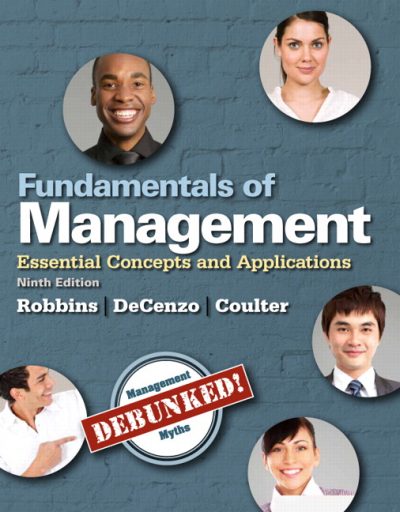

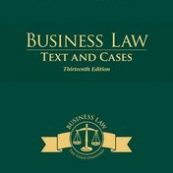

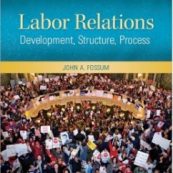


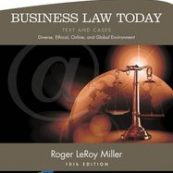
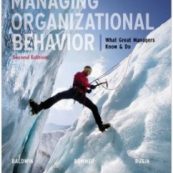
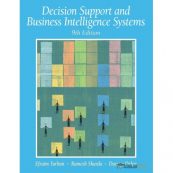
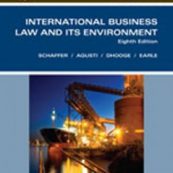
Reviews
There are no reviews yet.